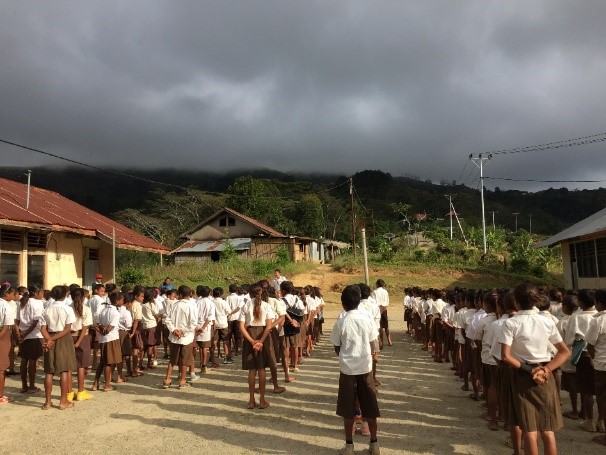 This article is more than 5 years old. Information may no longer be current.
This article is more than 5 years old. Information may no longer be current.
Community-based programs may lower odds of helminth infection
Source: Clarke et al, 2018.
About 25% of the world’s population — more than 1.5 billion people — are infected with soil-transmitted helminths, including hookworms, roundworms and whipworms. Soil-transmitted helminth infections, transmitted through soil contaminated with feces containing worm eggs, are some of the most common in the world and particularly affect resource-limited communities with poor sanitation.
Because soil-transmitted helminth (STH) infections can impair the physical and mental growth of children, control programs have typically involved providing anthelminthic drugs in schools, according to Naomi E. Clarke, MBBS, BMedSci, a doctoral student at Australian National University, and colleagues.
But newly published findings by Clarke and colleagues show that expanding STH control programs beyond schools and into the community may greatly reduce the odds of infection in children, and that concurrent improvements to water, sanitation and hygiene (WASH) further reduce transmission.
In a two-arm, nonrandomized cluster intervention trial conducted in the Southeast Asian country of Timor-Leste, Clarke and colleagues observed a 58% reduced risk for infection with Necator americanus, a hookworm, in children exposed to a communitywide intervention compared with the school-based intervention only.
Clarke and colleagues enrolled six communities in the study — three that received only a school-based deworming and WASH program, and three that received both school- and community-based programs. The findings were published in PLoS Neglected Tropical Diseases.
Besides delivering deworming medication to participants regardless of their infection status, the pilot study also provided schools with access to a reliable source of protected water, concrete latrines and hygiene education as part of the WASH program. In the intervention arm, households also received hygiene education. They were encouraged to reflect on their defecation practices and build household latrines. Deworming medication was delivered from house to house, also regardless of infection status.
The trend toward lower odds of N. americanus infection 6 months after the intervention (OR = 0.42; 95% CI, 0.07-2.36) did not reach statistical significance. Nor did a 57% reduction in the odds of higher-intensity infection in the intervention arm (OR = 0.43; 95% CI, 0.08-2.37). Clarke and colleagues said these outcomes were expected because the pilot study was not powered to detect these differences.
Despite these results, the researchers noted “high rates of both parental informed consent and participation of school-aged children in all aspects of the study.” For example, more than 90% of eligible children were recruited for the study, 92.3% of them provided stool samples at baseline, and 88.9% provided samples at follow-up. And the WASH intervention had positive impacts, improving school sanitation and reducing open defecation from 50.4% to 23.5% in the community.
“These results provide preliminary evidence and proof of principle for testing our hypothesis that a communitywide control program will be more effective at reducing STH infections in children than a school-based control program,” the researchers concluded. “Our findings agree with a recent meta-analysis, as well as with mathematical modeling studies, highlighting the additional benefits of expanding STH control programs communitywide.” – by Gerard Gallagher
Disclosures: The authors report no relevant financial disclosures.
Perspective
Back to Top
 Perspective
Perspective
In 2001, the World Health Assembly adopted a resolution to provide a single annual dose of an anthelminthic drug — typically either albendazole or mebendazole — in order to target school-aged children at risk in low- and middle-income settings for acquiring soil-transmitted helminth infections, especially ascariasis, trichuriasis and hookworm infections. The major goal of this global deworming approach was to reduce the morbidities resulting from worms in the intestines of hundreds of millions of children. Over the last 17 years, great progress has been made toward providing universal health coverage for this deworming approach, although only approximately 60% of the school-aged population has so far been reached.
In the meantime, the goals of mass drug administration approaches for neglected tropical diseases (NTDs) have shifted. Rather than focus only on morbidity control, there was interest in determining whether deworming protocols for soil-transmitted helminth infections could be adjusted to also achieve elimination. This was based on the successes of achieving some of the elimination targets for the major NTDs targeted through mass drug administration, including lymphatic filariasis, onchocerciasis and trachoma. One problem in achieving elimination was that deworming focused on school-aged children failed to interrupt transmission of soil-transmitted helminth infections, especially hookworm infection. This was because adults also have significant numbers of hookworms in their gastrointestinal tract and contribute to communitywide introduction of hookworm eggs in the environment. Accordingly, a group based at Imperial College London led by Sir Roy M. Anderson, FMedSci, developed mathematical models and frameworks to propose communitywide treatment of at-risk populations rather than children exclusively. Similar studies were also conducted by Nathan Lo, an MD/PhD student at Stanford medical school.
Clarke and colleagues found in a randomized study that indeed communitywide deworming, coupled with community-led sanitation, is superior to school-based deworming and sanitation, in terms of reducing the prevalence of soil-transmitted helminth infections in children, but especially hookworm. Therefore, there is an opportunity to improve soil-transmitted helminth control by shifting to communitywide approaches, which would also coordinate better with mass treatment programs for lymphatic filariasis, onchocerciasis and trachoma, as we first proposed in 2005.
Will this approach really lead to eliminating hookworm and other soil-transmitted helminths? Some investigators believe this is the case and have mathematical models to justify their assertions. However, we have pointed out that the efficacy of single-dose albendazole or mebendazole against both trichuriasis and hookworm infection is highly variable, and sometimes outright drug failure occurs. Therefore, we have advocated for the development of anthelminthic vaccines, which are now in clinical trials. However, the current paper is important because it does provide proof of concept that a communitywide and community-led approach to deworming offers benefits beyond school-based deworming programs.
References:
Hotez PJ. Lancet Infect Dis. 2017;doi:10.1016/S1473-3099(17)30484-X.
Lo NC, et al. Lancet Infect Dis. 2017;doi:10.1016/S1473-3099(16)30535-7.
Molyneux DH, et al. PLoS Med. 2005;doi:10.1371/journal.pmed.0020336.
Dean, National School of Tropical Medicine, Baylor College of Medicine
Endowed chair, tropical pediatrics, Texas Children’s Hospital
Disclosure: Hotez is the founding editor-in-chief of PLoS Neglected Tropical Diseases. He reports holding a patent on a hookworm vaccine.
Disclosures:
Published by:



